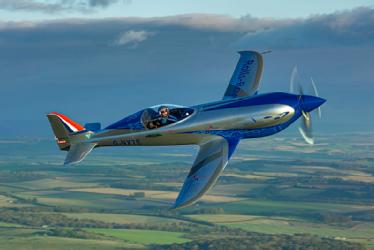WMG News - Latest news from WMG
Partnering with Rolls-Royce and Electroflight to create the battery for world’s fastest all-electric aircraft
- The Rolls-Royce ‘Spirit of Innovation’ aircraft is officially the world’s fastest all-electric aircraft, clocking up speeds of 387.4mph
- Rolls-Royce worked in partnership with aviation energy storage specialist Electroflight to create this world-class technical achievement for the UK, that will help lead the way towards a more sustainable way to fly
- In order to power the aircraft, the most power dense propulsion battery pack ever assembled in aerospace had to be developed directly supported by researchers from WMG, University of Warwick using their state-of-the-art battery characterisation and testing facilities
In the wake of COP26 the need for electrification has never been more evident, with aviation top of the list of global priorities.
Committed to taking on this challenge, Rolls-Royce decided to create the ‘Spirit of Innovation’, an all-electric aircraft, which this week officially set not one, but two World Records and during these record runs it reached speeds of 387.4mph (623 km/h) making it the world’s fastest all-electric vehicle.
but two World Records and during these record runs it reached speeds of 387.4mph (623 km/h) making it the world’s fastest all-electric vehicle.
In embarking on this unprecedented feat, Rolls-Royce partnered with aviation energy storage specialist Electroflight to help develop the battery system for the record-breaking plane. The WMG team at the University of Warwick were exclusively used to test and validate the batteries used on the aircraft.
Using their state-of-the-art facilities at WMG’s Energy Innovation Centre, researchers at WMG supported the team through the development process, conducting extensive electrical, thermal, safety, and vibration & shock testing. This was delivered all the way from Electroflight’s initial single lithium-ion cell selection through to the battery module and finally the battery pack for a full propulsion battery system.
Testing included cell selection, fire protection system design, module level thermal management, system testing and pack level testing, and also included sub-powertrain testing of the battery system and electric machines connected together.
Individual components such as the battery casing materials, individual lithium-ion cells, cell clusters and sub-modules were all examined in WMG’s battery testing laboratories including the Battery Abuse Testing Centre. Aerospace DO-160G shock and vibration testing was performed in WMG’s battery vibration facility – the first time an aircraft propulsion battery has successfully completed DO-160G testing in the UK.
On 16th November, the Spirit of Innovation took to the sky at the UK Ministry of Defence’s Boscombe Down experimental aircraft testing site for its record-breaking flight. Data was submitted to the Fédération Aéronautique Internationale (FAI), who control and certify world aeronautical records, have confirmed that the Spirit of Innovation is the world’s fastest electric plane.
The two new world records broken are:
1. The aircraft reached a top speed of 555.9 km/h (345.4 mph) over 3 kilometres, smashing the existing record by 213.04 km/h (132mph)
2. The aircraft achieved 532.1km/h (330 mph) over 15 kilometres – 292.8km/h (182mph) faster than the previous record
Chief Engineer Mark Amor-Segan, from WMG, University of Warwick comments:
“It’s incredibly exciting to see Rolls-Royce’s ‘Spirit of Innovation’ be awarded two new world records and officially be titled the World’s fastest all-electric aircraft. It has been a tremendous journey to share with Electroflight, to help verify and validate the battery system end-to-end and help create the most power-dense propulsion battery ever for Aerospace.
“We have worked closely with Electroflight and Rolls-Royce throughout this process, cementing new collaborative relationships and helping achieve world-class pioneering technology. To see it progress from literally a single cell into a full-scale battery system and a world-record breaking flight, is tribute to the incredible dedication and capability of the whole team at ACCEL. This project has played a very important part in our work in Aerospace, and we’re excited to continue our research into electrification and the future of sustainable flight.”
Douglas Campbell, Technical Director of Electroflight said:
“This has been a landmark project for our company and our industry – one which opens up a world of possibilities in the electrification of aviation. We’re thrilled to have played such an important part in this success and grateful to our partners at WMG for their support throughout this endeavour.”
Customer Director Matheu Parr from Rolls-Royce added: “The support we received from WMG to develop the battery technology that would power the world’s fastest all-electric aircraft was critical for the team’s record-breaking triumphs. Rolls-Royce has a long-standing relationship with WMG to ensure we are the forefront of technology and we will build on this capability to deliver propulsion and power systems for the advanced air mobility market.”
ENDS
26 JANUARY 2022
NOTES TO EDITORS
High-res images available at:
Pictures and B-Roll video footage can be found here:
https://www.flickr.com/photos/rolls-royceplc/albums/72157705298410174
https://vimeo.com/rollsroyceplc
Credit: Rolls-Royce
FOR FURTHER INFORMATION PLEASE CONTACT:
Alice Scott
Media Relations Manager – Science
University of Warwick
Tel: +44 (0) 7920 531 221
E-mail: alice.j.scott@warwick.ac.uk
